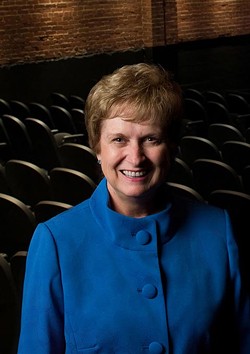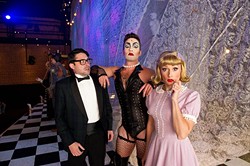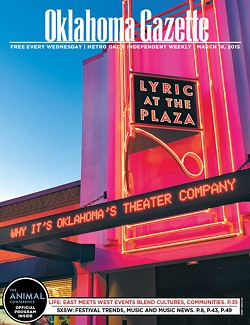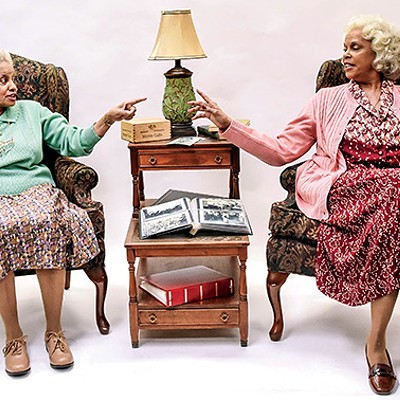On Nov. 7, 1962, 14 men and women filed into the elegant Beacon Club on the 24th story of 210 Park Ave. downtown. These notable community leaders, including E.L. Gaylord, were gathered that day at the behest of oilman John E. Kirkpatrick, who, after seeing a production of Bye Bye Birdie, had decided that something must be done.
Oklahoma must have a musical theater. The group quickly set up a board and went to work, making its mission to “produce quality professional theatre ... encourage and educate talented individuals ... promote collaboration among the arts ... and enrich the quality of life for the people of Oklahoma.”
A few weeks later, on Jan. 9, 1963, newly-christened Lyric Theatre launched an inaugural three-show summer season beginning with the beloved musical Oklahoma! The board agreed that Oklahoma City University (OCU) would be a good choice to house the fledgling company, and the two organizations began what would become the premier theater in the state.
After a brief learning curve for patrons — who attempted to leave during a scene change following an hour-and-a-half-long first scene — the theater met with quick success. The show season expanded from three to four and five shows under Artistic Director Carveth Osterhaus.
Despite its rising popularity, the company had its struggles. For roughly the first six years, there were financial problems, even though OCU was contributing and Kirkpatrick had given the organization a sizable loan, said Paula Stover, a former volunteer and board president and current executive director of Lyric Theatre.
To save on costs, the company developed what would come to be known as The Guild. Composed of nearly 400 mostly female volunteers, The Guild cut costs by supplying the womanpower to run the box office, concessions, advertising, subscriptions and fundraisers and even cooking for opening night parties.
In 1971, Lyle Dye stepped in as art director, raising the company’s standards and enhancing its profile. He formed a partnership with music director Joel Levine, whose accomplishments at the theater led him to renowned positions with the Oklahoma City Symphony Orchestra and the present-day Oklahoma City Philharmonic.
Contrary to what you might hear, Stover said, Lyric established a precedent of bringing in outside talent from the start, even if it was from Kansas City, Missouri, or Dallas. This formed the cornerstone of the Lyric design today, offering less experienced local performers the chance to work with acclaimed outside talent and grow to greater heights.
With these pieces in place, Lyric built momentum, performing at OCU until 2002, when the next page was turned and the company invigorated its ascent to the forefront of American musical theater.
Even better
In 2002, Lyric repositioned itself in newly renovated Civic Center Music Hall. The Civic Center, which undertook a $53 million investment as part of the Metropolitan Areas Project (MAPS), was an appealing prospect. Then under the direction of Stover and Artistic Director Nick Demos, the company moved from a venue with hundreds of seats to one with 2,477.
“It was a perfect time for us when it came back,” Stover said. “We had been wanting to go down there for years.”
For the opening performance on June 25, 2002, Lyric produced dance spectacular The Will Rogers Follies. It has staged its summer season at the Civic Center every year since, performing six productions of four large-scale musicals over two months.
“Our model makes it easier to do true large-scale musicals, which sets us apart,” said Michael Baron, Lyric artistic director. “We have the freedom to see things in new ways and visualize in new ways because we build our sets specifically for the scale of the Civic, whereas the touring productions build one set to fit different venues.”
Last year, Lyric performed Les Misérables, with a cast of 45 people, a choir of 55 and a floor orchestra. The national tour that came through two years prior had a cast of 23 and an orchestra of 10.
The scale allows the company more creativity with traditional large productions, Baron said, such as this season’s Oklahoma!, Mary Poppins and Billy Elliot, while allowing for experimentation with new musicals such as July’s Big Fish.
Solidifying its position as a major theater player, Lyric had more in store and purchased two unassuming buildings along the rundown pavement of 16th Street in a move that would help restore one of OKC’s oldest districts.
Revitalization
Neither Stover nor Baron look back fondly on the state of the Plaza District when Lyric first considered the properties at 1727 and 1801 NW 16th St., but they like where it got them.
Demos wanted to make Lyric a year-round theater, and board member Lou Kerr knew just the space in which to make that happen.
The state’s first air-conditioned movie theater in 1935, Plaza Theatre was a dilapidated mess when the group first moved in.
“[The area] was really quiet,” Stover said. “There was an old mattress shop and Laundromat. It was broken, the way the streets were up to the buildings ... ugly ... dirt ... broken concrete.”
Baron said the group remained undaunted by the shambles.
“The theater was abandoned with birds and things,” he said. “But the board remembered going to the movies here and wanted to rejuvenate the theater and have a year-round place for the academy kids to perform.”
Before they could start, however, the green paper thing that always seems to get in the way — money — got in the way. Enter Mike Turpen, a board member and former board president.
With Turpen’s business pitch to educate students to “break the silence of a room with the sound of their voice” and preserve a key piece of history, Lyric raised $10 million to renovate what would become Lyric at the Plaza and Thelma Gaylord Academy.
The 279-seat theater breathed a new life in 2007, adding two shows in the spring and fall to round out Lyric’s yearly productions to eight per year.
“We had all these thoughts that it would be a big rental income for us when we weren’t in there,” Stover said. “In just a couple years’ time, we were doing so much in there we rented for very few things. Now, [we’re so busy] that we have to save one window where they do cleaning and maintenance.”
As Plaza Theatre grew roots, the surrounding neighborhood bloomed. Shops opened, and new roads were put in. Due to MAPS — and in large part to the Plaza District Association— the district’s beauty emerged.
“The Plaza District Association worked really hard over the years,” Stover said. “One of the first things they did was come and talk to us because, at that time, we didn’t have the theater done yet and they wanted to know if we were really going to open. Once we opened, it really started moving with businesses moving in and redoing the buildings.”
Baron added that businesses are sustainable now because they can thrive on the attraction of the arts.
With the support a flourishing district provided, the theater gained traction among both the traditional older generations and younger crowds.
The Plaza Theatre also provided intimacy. Edgier shows like Spring Awakening or Xanadu offer nice complements to Civic Center classics, while staples such as The Rocky Horror Show and A Christmas Carol rope in loyal followings.
“The audiences are full,” Baron said. “When I first got here, I was hoping we’d have 50 people to a show. Now, we never have less than 150 to 175. It’s full for the kids show too.”
Just down the street is Thelma Gaylord Academy, which functions as the youth and outreach branch of Lyric Theatre. Servicing youth ages 6-18, it nurtures young talent and instills in them an appreciation for theater. It also offers scholarships to guarantee that whoever wants to attend can.
“If these kids continue, they’ll go on to college and conservatory programs, but if not, they’ll have confidence from the school if they want to be a lawyer,” Baron said.
The kids take classes and attend summer programs. Just because the actors are half-size doesn’t necessarily mean the productions they put on are too. Students can participate in one full-scale production each semester and can audition for the summer camp held each June. Past productions include Sweeney Todd: The Demon Barber of Fleet Street, Urinetown: The Musical and Cats. Many students also fill young secondary roles in the company’s main productions.
“Most musicals that might be programmed for kids are licensed as a junior version around an hour and 15 minutes,” Baron said. “A lot of times, we don’t do the junior version; we do the full with all the costumes, and the kids sing all the songs.”
All in all, Lyric puts on eight main-stage professional shows and six academy shows, including musicals by age group, a summer musical, a full academy musical and a rock academy in which students create a rock musical led by Matthew Alvin Brown.
The three-pronged theater built a stable place for itself with big and small stage productions and a pipeline academy. But its success isn’t just on the local level, where it sells out shows and nurtures community relations.
From its start at OCU, the theater has established a reputation for developing talent not only through the academy but through its practice of bringing in big names for principal roles, directors and designers and filling out ensembles with local performers who can learn from direct experience with the pros.
Big names such as Megan Mullally, Lucille Lortel Award-winner Annie Funke and two-time Tony-winner Chita Rivera stick out among a host of other Broadway and national performers Lyric recruited.
Other names like Sasha Hutchings, now in the off-Broadway hit Hamilton, and Christopher Rice in Broadway’s The Book of Mormon went the other way, starting at Lyric and gaining prominent roles on American theater’s biggest stages.
From back to front
Christopher Rice made his Lyric debut at age 10 as Winthrop in The Music Man.
“Being exposed to the professionalism as a child and having that expected of me as an adult was fantastic,” Rice said, “because no matter where you live, you won’t always have New York brought to you. But Lyric does a really good job of doing that.”
Into high school, he took dance, voice or acting lessons every afternoon. He took advantage of the work-study scholarship program the academy offered, sweeping floors, taking out trash and doing other chores in exchange for extra or discounted classes.
As he progressed in his studies and talents, he began taking performing more seriously.
“I grew up on the classic musicals and Disney movies like Beauty and the Beast,” Rice said. “I was always running around the house, singing and dancing. I didn’t realize you could make a living of it.”
Between child roles and his production roles as an adult, Rice did backstage dressing. He loved being a part of the shows in any way he could. With all his talents and willingness to contribute, it isn’t surprising his breakout came so quickly.
“The training the academy provided as well as the live experience and the chance to perform with Broadway professionals ... there’s really nothing that can replace those experiences,” Rice said.
After graduating from the University of Oklahoma in 2011 and performing in Lyric’s A Chorus Line, The Who’s Tommy, Disney’s High School Musical and The Producers, Rice moved to New York. After his first audition, he was cast in the Broadway tour of West Side Story. Immediately following that came a role in White Christmas and after that, his current The Book of Mormon role.
“In seven years, he’s gone from being a dresser backstage to being on Broadway,” Baron said.
Carrying the mantle
“I think our reputation is wonderful,” Stover concluded. “I think a lot of people don’t realize we’re really the only theater like this in the state.”
Having spent more than 50 years establishing and refining itself, Lyric looks to further improve its reputation. Part of that includes an increased focus on its interactive youth outreach program, which provides theater performances and education to more than 35,000 Oklahoma children.
As Lyric and the city grow, the theater needs to become a more diverse organization, Baron said.
“There are three parts to our future,” Baron said. “Maintain the classics in the large scale they were written, expand our new works program and expand the academy and involve the community more.”
Print headline: Oklahoma’s Theatre, After 50 years of developing local talent and recruiting nationally acclaimed performers, Lyric Theatre is the state’s premiere performance stage.
Print headline: Oklahoma’s Theatre, After 50 years of developing local talent and recruiting nationally acclaimed performers, Lyric Theatre is the state’s premiere performance stage.

















